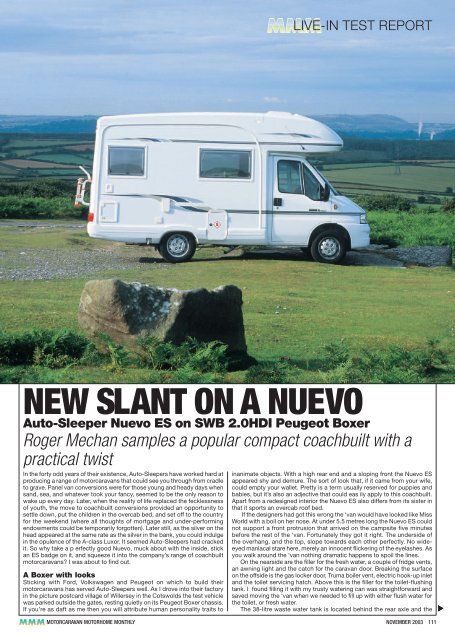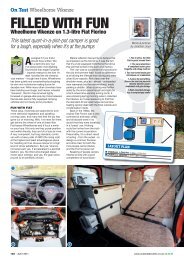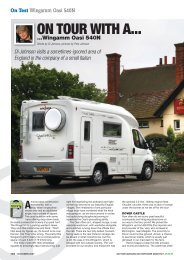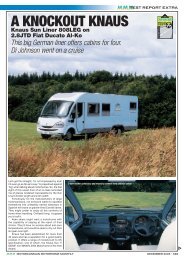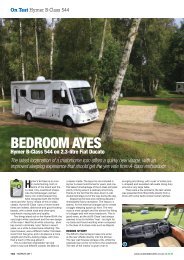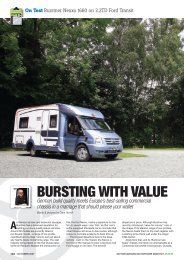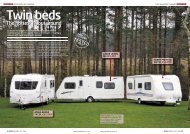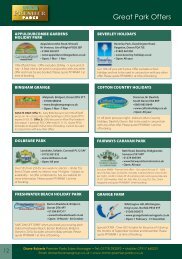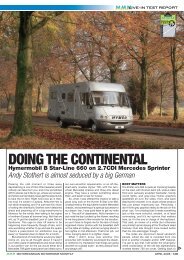NEW SLANT ON A NUEVO - Out and About Live
NEW SLANT ON A NUEVO - Out and About Live
NEW SLANT ON A NUEVO - Out and About Live
Create successful ePaper yourself
Turn your PDF publications into a flip-book with our unique Google optimized e-Paper software.
LIVE-IN TEST REPORT<br />
<strong>NEW</strong> <strong>SLANT</strong> <strong>ON</strong> A <strong>NUEVO</strong><br />
Auto-Sleeper Nuevo ES on SWB 2.0HDI Peugeot Boxer<br />
Roger Mechan samples a popular compact coachbuilt with a<br />
practical twist<br />
In the forty odd years of their existence, Auto-Sleepers have worked hard at<br />
producing a range of motorcaravans that could see you through from cradle<br />
to grave. Panel van conversions were for those young <strong>and</strong> heady days when<br />
s<strong>and</strong>, sea, <strong>and</strong> whatever took your fancy, seemed to be the only reason to<br />
wake up every day. Later, when the reality of life replaced the fecklessness<br />
of youth, the move to coachbuilt conversions provided an opportunity to<br />
settle down, put the children in the overcab bed, <strong>and</strong> set off to the country<br />
for the weekend (where all thoughts of mortgage <strong>and</strong> under-performing<br />
endowments could be temporarily forgotten). Later still, as the silver on the<br />
head appeared at the same rate as the silver in the bank, you could indulge<br />
in the opulence of the A-class Luxor. It seemed Auto-Sleepers had cracked<br />
it. So why take a p erfectly good Nuevo, muck about with the inside, stick<br />
an ES badge on it, <strong>and</strong> squeeze it into the company’s range of coachbuilt<br />
motorcaravans? I was about to find out.<br />
A Boxer with looks<br />
Sticking with Ford, Volkswagen <strong>and</strong> Peugeot on which to build their<br />
motorcaravans has served Auto-Sleepers well. As I drove into their factory<br />
in the picture postcard village of Willersey in the Cotswolds the test vehicle<br />
was parked outside the gates, resting quietly on its Peugeot Boxer chassis.<br />
If you’re as daft as me then you will attribute human personality traits to<br />
inanimate objects. With a high rear end <strong>and</strong> a sloping front the Nuevo ES<br />
appeared shy <strong>and</strong> demure. The sort of look that, if it came from your wife,<br />
could empty your wallet. Pretty is a term usually reserved for puppies <strong>and</strong><br />
babies, but it’s also an adjective that could eas ily apply to this coachbuilt.<br />
Apart from a redesigned interior the Nuevo ES also differs from its sister in<br />
that it sports an overcab roof bed.<br />
If the designers had got this wrong the ‘van would have looked like Miss<br />
World with a boil on her nose. At under 5.5 metres long the Nuevo ES could<br />
not support a front protrusion that arrived on the campsite five minutes<br />
before the rest of the ‘van. Fortunately they got it right. The underside of<br />
the overhang, <strong>and</strong> the top, slope towards each other perfectly. No wideeyed<br />
maniacal stare here, merely an innocent flickering of the eyelashes. As<br />
you walk around the ‘van nothing dramatic happens to spoil the lines.<br />
On the nearside are the filler for the fresh water, a couple of fridge vents,<br />
an awning light <strong>and</strong> the catch for the caravan door. Breaking the surface<br />
on the offside is the gas locker door, Truma boiler vent, electric hook-up inlet<br />
<strong>and</strong> the toilet servicing hatch. Above this is the filler for the toilet-flushing<br />
tank. I found filling it with my trusty watering can was straightforward <strong>and</strong><br />
saved moving the ‘van when we needed to fill up with either flush water for<br />
the toilet, or fresh water.<br />
The 38-litre waste water tank is located behind the rear axle <strong>and</strong> the<br />
▼<br />
MOTORCARAVAN MOTORHOME M<strong>ON</strong>THLY NOVEMBER 2003 111
AUTO-SLEEPER <strong>NUEVO</strong> ES <strong>ON</strong> SWB 2.0HDI PEUGEOT BOXER<br />
Filler for toilet flush tank is above the cassette access door. Gas compartment holds two<br />
6/7kg cylinders.<br />
drain hose is right at the bottom, so there should be no residual water left<br />
in the tank to putrefy. The drain tap for this tank is easily accessed. The<br />
outboard fresh water tank is in front of the rear axle, on the offside. It<br />
accommodates 47 litres <strong>and</strong>, again, the drain tap is easily accessed.<br />
The distance from the front bumper to the ground is around 280mm <strong>and</strong><br />
from the rear bumper to the ground around 530mm, which gives the<br />
impression the ‘van is on tiptoe. A not unattractive feature. It is also a very<br />
practical feature if ever you have the misfortune to need to access the spare<br />
wheel. This is located under the vehicle, in a cradle behind the waste tank,<br />
some 900mm from the rear of the ‘van. There is no other way to access it<br />
other than lying underneath, undoing the cradle nuts with a spanner <strong>and</strong><br />
dragging the spare wheel with you as you crawl out. My advice would be<br />
to join a rescue service. It is difficult to see where else the spare wheel could<br />
go, although it would be better relocated nearer to the rear bumper.<br />
Whilst it’s not polite to dwell too long on a lady’s derrière, I have to say<br />
the Nuevo ES has an attractive one, <strong>and</strong> it is not all plastic. A large opening<br />
window for the rear kitchen does away (in part) with the need for a noisy<br />
cooker hood <strong>and</strong> the smart silver-effect Auto-Sleepers badge adds a touch<br />
of understated class.<br />
My main observation about the rear concerns the cycle rack, the top bar<br />
of which, when not in use, catches your eye when driving. I found myself<br />
constantly thinking vehicles were too close - which caused a double take,<br />
<strong>and</strong> a delay when checking the rear view mirror prior to overtaking. If the<br />
rack bar could be lowered by a few inches it would solve this problem.<br />
A plus point is that only two keys are needed. One does the central<br />
locking for the cab doors, the ignition <strong>and</strong> the fuel filler cap. The other deals<br />
with all locks on the caravan side.<br />
A Boxer with punch?<br />
With only the 85bhp 2-litre turbo-diesel under its bonnet I wondered if<br />
Peugeot’s rampant lion, prancing around ostentatiously on the front grille,<br />
was flattering to deceive. After all, a fully loaded Nuevo ES would be<br />
packing 3300kg <strong>and</strong> it would need more than an over-excited lion to drag<br />
that lot at a decent pace. In truth it wasn’t too much of a problem. There was<br />
plenty of acceleration in all gears on the flat, but the dash-mounted (fivespeed)<br />
gearstick needed constant stirring when making haste.<br />
An absence of turbo lag was noticeable, although there was a lot of turbo<br />
whine, <strong>and</strong> on the flat the engine ran out of steam at around 58mph in third<br />
gear. Whilst hills could not be bounded in a single leap, or in this case a<br />
single gear, judicious use of the gearbox while keeping the revs up made<br />
light work of most of them. Overtaking again required a degree of planning<br />
<strong>and</strong> once I understood the limits of each gear, particularly third, I found the<br />
The drains for the fresh <strong>and</strong> waste water tanks are located on the near <strong>and</strong> offside in<br />
front of the rear wheels. They drain freely <strong>and</strong> are easy to get to.<br />
The spare wheel is located behind the waste tank <strong>and</strong> is difficult to access.<br />
engine to be quiet, hardworking <strong>and</strong> responsive. If you are the sort that is<br />
never in a hurry then the 2-litre HDI should be a consideration. Otherwise,<br />
invest in the extra 15bhp that the 2.2HDI has to offer. The additional £1644<br />
could be money well spent.<br />
On the road there was some wind noise apparent at high speed,<br />
particularly from the small vent in the overcab bed, although pulling the<br />
blind mitigated it somewhat. Previous to setting off in the Nuevo ES I had<br />
spent some time driving a 2-litre turbo-diesel Fiat. It takes a different badge<br />
on the steering wheel when sitting in the cab to tell the Boxer <strong>and</strong> the Fiat<br />
apart. Both have electric windows <strong>and</strong> mirrors, both have decent sized<br />
pockets on the driver <strong>and</strong> passenger doors, <strong>and</strong> both have s quab, rake <strong>and</strong><br />
lumbar adjustment for the driver’s seat. There is also an adjustable steering<br />
column in both. Although the vehicles seemed well matched for power, the<br />
main difference, apart from the constant turbo whine from the Peugeot, was<br />
in the road-holding department. The Boxer chassis felt stiffer <strong>and</strong> there was<br />
less body roll when cornering.<br />
In a clinch with the Boxer<br />
You have to pull out the manual step to get into the ‘van. (I know a lot of<br />
‘vans still have manual steps but it does seem very dated.) The one-piece<br />
caravan door has a window with blind <strong>and</strong> flyscreen - but the flyscreen<br />
Top bar of the cycle rack partially obscures the driver’s rearward view.<br />
The Nuevo’s 2-litre power plant performed well with judicious use of the gears.<br />
112 NOVEMBER 2003 MOTORCARAVAN MOTORHOME M<strong>ON</strong>THLY
LIVE-IN TEST REPORT<br />
Manually-operated step cuts down on manufacturing costs but an electric one would be<br />
better. A warning buzzer sounds in the cab if the step is left out.<br />
seems unnecessary, as the window doesn’t open. Once inside we were<br />
greeted by a very attractive dark blue carpet that in ten seconds was<br />
covered in grass - <strong>and</strong> a further ten seconds later was on its way out of the<br />
door to spend the rest of its time in the garage to await our return. I have to<br />
say it really looked great <strong>and</strong> it’s not the carpet, it’s me. Bits seem to drop<br />
off me to such an extent that I would be constantly shaking the thing outside<br />
to the consternation of all <strong>and</strong> sundry. Being left with an attractive parqueteffect<br />
easy-clean floor was much better. At least for me.<br />
Unfortunately this luxurious blue pile extended into the driver’s cab floor<br />
<strong>and</strong>, as it was permanently fixed over the grey factory-fitted flooring, dust<br />
clouds were not completely abolished. I would have liked a rubber insert<br />
where the driver’s foot rested on the floor as the carpet here was beginning<br />
Cab carpet is not removable <strong>and</strong> after only a few hundred miles marks where the<br />
accelerator foot meets the floor were beginning to show.<br />
to show signs of wear after only 800 miles. However, if unlike me you are not<br />
a grass magnet, you will find this carpet a pleasure to walk on. Once the<br />
carpet had been sorted out - two things came over very strongly about the<br />
interior; space <strong>and</strong> light. It was now dawning on me why this ‘van had been<br />
conceived.<br />
The layout is fairly straightforward. Rear kitchen, washroom on the rear<br />
offside, overhead cab bed accessed via a ladder, overhead <strong>and</strong> floormounted<br />
storage cup boards, <strong>and</strong> a wardrobe alongside the washroom. In<br />
a way, all pretty conventional. The difference comes with the seating. Two<br />
cab seats <strong>and</strong> two forward-facing rear seats, all with three-point inertiareel<br />
seat belts, are only part of the story. It is the space between the seats,<br />
<strong>and</strong> the way that space has been used, that we found unique <strong>and</strong> enjoyable.<br />
▼<br />
MOTORCARAVAN MOTORHOME M<strong>ON</strong>THLY NOVEMBER 2003 113
AUTO-SLEEPER <strong>NUEVO</strong> ES <strong>ON</strong> SWB 2.0HDI PEUGEOT BOXER<br />
Looking forward from the kitchen reveals a versatile <strong>and</strong> spacious lounge.<br />
If you are travelling in either of the rear seats you will have 700mm<br />
between you <strong>and</strong> the rear of the seat in front. You will look through a large<br />
picture window to watch the world go by <strong>and</strong> you will be 490mm from the<br />
person alongside. Perfect for adults with long legs, <strong>and</strong> still within fighting<br />
distance for children. But you will find it easy to separate the kids when the<br />
need arises - through the large windows you can point out to them the bus<br />
stop they will be dropped at if they don’t buck their ideas up!<br />
So that’s the quick tour, but how does it look under the microscope?<br />
Kitchen matters<br />
Located at the rear of the ‘van, the kitchen sports a Caprice 2040E domesticstyle<br />
cooker with three gas burners <strong>and</strong> one electric burner. A gas grill, gas<br />
oven <strong>and</strong> electronic ignition complete the set-up. A grill pan, baking tin <strong>and</strong><br />
tray are provided <strong>and</strong> there is a drop-down door at the bottom of the cooker<br />
giving access to ample storage for pots <strong>and</strong> pans. The Caprice has a wire<br />
grille covering the burners that is held firmly in place by clips. This grille<br />
presses down on the burner covers, which are also screwed into place,<br />
resulting in a virtually rattle-free hob. Alongside the cooker is a stainless steel<br />
drainer <strong>and</strong> sink with a mixer tap. The cover of the sink also doubles as a<br />
chopping board. The cover is not removable but when closed rests on rubber<br />
stops, again reducing the chance of any annoying rattles from this area.<br />
There is a domestic-sized plughole in the sink that drains freely.<br />
Directly under the sink is a double-fronted cupboard with sufficient<br />
space for towels, both cloth <strong>and</strong> paper, a pull-out cutlery t ray <strong>and</strong> a waste<br />
bin. On the wall to the right of the sink is a spice rack, with additional storage<br />
provided by two overhead cupboards. Illumination comes from one<br />
overhead fluorescent light <strong>and</strong> the aforementioned opening window with<br />
cassette blind <strong>and</strong> flyscreen.<br />
Looking rearward: a familiar layout with the kitchen across the rear <strong>and</strong> the washroom in the offside corner next to<br />
the wardrobe. Forward-facing seats dominate the lounge.<br />
▼<br />
Two belted forward-facing passenger seats for safe comfortable rear travel.<br />
114 NOVEMBER 2003 MOTORCARAVAN MOTORHOME M<strong>ON</strong>THLY<br />
▼
LIVE-IN TEST REPORT<br />
Undersink cupboard houses a pull-out cutlery tray <strong>and</strong> waste bin.<br />
The cooker has three gas <strong>and</strong> one electric burners, a grill, <strong>and</strong> an oven. At the bottom<br />
is storage for pots <strong>and</strong> pans. Fridge is in the foreground of the picture.<br />
▼<br />
Immediately to the left of the door, <strong>and</strong> within the kitchen area, is the<br />
70-litre three-way Dometic fridge with full-width freezer. The top working<br />
surface of the fridge measures 610mm x 560mm. There is one 230V<br />
switched socket here together with a 12V socket. These serve the whole of<br />
the ‘van. That’s a shame. If you’re watching TV, for example, or downloading<br />
digital pictures for your laptop, then you have to either stop what you’re<br />
doing or boil your water for your tea on the cooker. Extra sockets would cost<br />
little to install <strong>and</strong> give greater versatility. On the wall behind the fridge is a<br />
useful storage rack <strong>and</strong> above that a small cocktail cabinet with four glasses<br />
provided. No free wine though, unfortunately!<br />
Extra food preparation space is provided by a pull-out top, s<strong>and</strong>wiched<br />
between the fridge <strong>and</strong> the fridge-top work surface. This measures a decent<br />
470mm x 480mm. It does hinder free movement through the ‘van when fully<br />
extended, but this was not a problem. Taken as a whole, the kitchen setup<br />
was practical, pleasant to work in <strong>and</strong> lacked for nothing in the way of<br />
storage or equipment.<br />
Once you’ve prepared your food it’s nice to have somewhere pleasant to<br />
eat it <strong>and</strong> this is where the seating configuration of the Nuevo ES scores.<br />
Two small pedestal tables are provided (kept, with their legs, in designated<br />
storage areas in the wardrobe). On the floor are four sockets for positioning<br />
the tables, depending on the seating configuration. You can choose bench<br />
seats. Or, by swivelling both cab seats, four people can sit on separate<br />
MOTORCARAVAN MOTORHOME M<strong>ON</strong>THLY NOVEMBER 2003 115<br />
▼
AUTO-SLEEPER <strong>NUEVO</strong> ES <strong>ON</strong> SWB 2.0HDI PEUGEOT BOXER<br />
The fridge-top work surface hides a useful pull-out section, although when deployed it<br />
hinders free movement through the ‘van.<br />
Above the fridge we find the only mains socket <strong>and</strong> a cocktail cabinet with fitted glasses.<br />
In bench seat mode the feet-up lounging is great for two.<br />
chairs. With either configuration two would share one table. Take away the<br />
tables in either configuration <strong>and</strong> the same observations go for what then<br />
becomes the lounge.<br />
This lounge can be used comfortably by four where everyone has their<br />
own seat, or two can sit feet up by extending the rear seats into bench seat<br />
mode. I enjoyed the versatility this system provided; it was like having two<br />
‘vans in one. All the seats are comfortable <strong>and</strong> covered in an attractive,<br />
hardwearing cloth. We found the modern grey upholstery, soft blue curtains<br />
<strong>and</strong> deep blue wall <strong>and</strong> floor coverings very nautical. Four overhead palecoloured<br />
wood storage cabinets <strong>and</strong> four large, curved lights for the lounge<br />
add to the overall feeling of quality.<br />
Boxed up for the night<br />
All the windows have curtains, <strong>and</strong> cassettes housing concertina blinds <strong>and</strong><br />
flyscreens. On the test vehicle Auto-Sleepers were trying out an innovation;<br />
concertina blinds for the front <strong>and</strong> side cab windows in place of screens.<br />
The blinds are reflective on the outside <strong>and</strong> heat retentive on the inside.<br />
When dep loyed, they make the cab area feel an integral part of the caravan<br />
Two pedestal tables <strong>and</strong> four floor sockets allow eating from the bench seats…<br />
…or the forward-facing <strong>and</strong> swivelled cab seats as two Pullman-style dinettes.<br />
116 NOVEMBER 2003 MOTORCARAVAN MOTORHOME M<strong>ON</strong>THLY
LIVE-IN TEST REPORT<br />
The lounge seating converts to make a comfortable transverse double bed.<br />
Prototype cab door blinds are very easy to operate <strong>and</strong> secure by means of a magnetic strip. On the driver’s side<br />
the wing mirror is partially obscured by the cassette holder.<br />
set-up. The side blinds appeared a little flimsy, but if they are deployed<br />
carefully they should last the lifetime of the ‘van.<br />
The blind for the windscreen is contained in a cassette fixed to the<br />
interior side pillars. The rear view mirror has to be removed <strong>and</strong> the blind<br />
then slides easily along runners to cover the windscreen. The cassette<br />
obscures around three inches of the bottom of the windscreen, which did<br />
not obstruct my vision or make driving unsafe. However, the cassette that<br />
houses the door blinds on the driver’s side does obstruct a portion of the<br />
wing mirror if you have your seat set right back. Whichever window covers<br />
you choose, blinds or screens, you still retain the use of the curtains to close<br />
around the cab seats.<br />
Having used them during this test, I would have no hesitation in opting<br />
We found the blinds easy to use, although you do have to remove the rear view mirror.<br />
Their use made the cab area an integral part of the caravan.<br />
▼<br />
for the cab blinds. They do look like a DIY add-on, but in practice they<br />
worked well.<br />
If you thought the versatility of the rear seats only extended to eating <strong>and</strong><br />
lounging then think again. Press a lever at the front of both seat squabs <strong>and</strong><br />
they glide forward on runners. Place the backrests in the space that is<br />
opened up <strong>and</strong> you are halfway to making your bed. At the top of each<br />
kickboard an arm extends to bridge the open corridor between the seats <strong>and</strong><br />
it is on these arms that the longitudinal backrests from the settee are placed<br />
to fill in the centre. This produces a double bed measuring 1.98m x 1.42m (6ft<br />
6in x 4ft 7in). Normally I am not a great lover of beds that utilise too many<br />
cushions, but because I was sleeping at right angles to the joins, <strong>and</strong> as we<br />
use an overlay of old sleeping bags, this transverse bed was very<br />
comfortable. And it was easy to make, but there were a couple of things to<br />
watch when constructing the bed. A leg on the back of the centre cushions<br />
has to be deployed vertically to keep the cushions stable. We found the<br />
press-stud secured ties keeping the le g in the vertical came away too easily<br />
when these cushions moved. This happened when kneeling on them to climb<br />
into bed. It had the effect of pushing the horizontal cross support away,<br />
resulting in the centre section of the bed caving in. It is also worth bearing in<br />
mind that if the overcab bed is being used at the same time as the lounge<br />
bed then a home has to be found for the folding ladder. We found it would lay<br />
across the cab seats quite comfortably. Remember also that any night visits<br />
to the loo by the occupants of the overcab bed will require a crawl across<br />
those sleeping downstairs (a facet of many motorcaravans with this set-up).<br />
I liked this configuration very much as it was simple <strong>and</strong> quick to construct.<br />
It just needs a little more thought given to securing those centre cushions.<br />
The overcab bed could accommodate two adults but if I slept there I<br />
would prefer to do so on my own, as it would be a little claustrophobic for<br />
a person on the inside. The maximum height at the front is 560mm <strong>and</strong><br />
minimum comfortable turning space, for an adult, is around 480mm before<br />
the ceiling starts to curve down towards the front. This bed will happily<br />
accommodate a couple of young children, <strong>and</strong> has large fluorescent lights<br />
on both bulkheads. The downside is a lack of ventilation, as there is only a<br />
small push-up roof vent for an area that can get very hot, particularly when<br />
The legs supporting the bed’s centre section displayed a tendency to ‘cave in’.<br />
The overcab bed is a full double – but, like many, it would be better suited to a couple of kids.<br />
▼<br />
MOTORCARAVAN MOTORHOME M<strong>ON</strong>THLY NOVEMBER 2003 117
AUTO-SLEEPER <strong>NUEVO</strong> ES <strong>ON</strong> SWB 2.0HDI PEUGEOT BOXER<br />
The ‘very good’ bathroom has a fixed basin <strong>and</strong> separate shower taps…<br />
…along with an opening window <strong>and</strong><br />
electric flush loo.<br />
User-friendly control panel <strong>and</strong> heating<br />
controls are grouped together.<br />
▼<br />
the curtains are across. There is a<br />
safety net for the front <strong>and</strong> a felt bag<br />
to hold the sturdy, folding metal<br />
ladder. Auto-Sleepers have done<br />
their usual clever trick with this bed<br />
by hinging the front section to make a<br />
larger space to pass from the cab to<br />
the caravan.<br />
A rub down in the corner<br />
The bathroom is located on the rear offside. It is a pleasant room with blue<br />
washable wall covering, push-up roof vent <strong>and</strong> opening window with blind<br />
<strong>and</strong> flyscreen. On the left on the wall when entering is a soap dispenser.<br />
There’s a wall mirror with a protrusion underneath - if it is meant to be a<br />
shelf, it doesn’t work! A deep corner basin has mixer tap <strong>and</strong> large plughole.<br />
Above the basin is a corner column consisting of a soap holder, toothbrush<br />
holder <strong>and</strong> vertical twin-lamp fluorescent light. Beneath the basin is a<br />
plastic, concave, double-fronted cupboard.<br />
To the right of the window is the shower with its own mixer taps, while<br />
on the back <strong>and</strong> side walls are towel rail <strong>and</strong> clothes hooks. In the corner is<br />
the excellent Thetford cassette swivel toilet that gives maximum legroom of<br />
around 560mm, measured from the front of the seat to the cupboard under<br />
the basin. The shower floor has a removable, synthetic, slatted shower mat<br />
<strong>and</strong> there are two domestic-sized plugholes to drain the shower water.<br />
An easy-glide shower curtain protects the door, <strong>and</strong> the shower hose is<br />
long enough to pass through the window to the outside. This room is as<br />
big as it needs to be for the purpose it serves <strong>and</strong> is a light <strong>and</strong> airy<br />
environment in which to perform on e's ablutions. My one complaint is<br />
inadequate storage. I would do away with the rear towel rail <strong>and</strong> have a<br />
double-fronted cupboard in its place; there appears to be adequate space<br />
to do this <strong>and</strong> it would turn a very good washroom into an excellent one.<br />
Shower hose will reach outside to wash the s<strong>and</strong> off your feet.<br />
Boxer shorts<br />
We are now virtually at the end of our tour of this Nuevo, but a few points are<br />
worth noting.<br />
118 NOVEMBER 2003 MOTORCARAVAN MOTORHOME M<strong>ON</strong>THLY
LIVE-IN TEST REPORT<br />
The master control panel is located on the side of the wardrobe. An<br />
analogue readout gives fresh water level, <strong>and</strong> caravan <strong>and</strong> vehicle battery<br />
conditions. There is no waste water level indicator. This panel also houses<br />
the engine/leisure battery switch, pump switch <strong>and</strong> caravan lights master<br />
switch. Underneath are the graduated controls for the gas/electric water<br />
heater. The leisure battery is located under the front seat.<br />
The wardrobe is a good size <strong>and</strong> houses the tables <strong>and</strong> table legs, the<br />
RCD with three MCBs, gas isolator valves, <strong>and</strong> t he master switches for<br />
electric operation of the water heater <strong>and</strong> space heater.<br />
The Truma space heater located under the wardrobe could be unique in<br />
motorcaravan history, as it doesn’t rattle. It does, however, pump out heat<br />
(powered by a choice of gas or mains electricity) to ducts in the washroom<br />
<strong>and</strong> lounge.<br />
More storage can be found under the rear passenger seat squabs where<br />
there is enough room to store electric leads, hiking boots, levelling blocks<br />
<strong>and</strong> the like. It would have been useful if we could have accessed this space<br />
from outside. Although our aluminium roll-up table fitted under the seats we<br />
had to leave our outside chairs lying on the floor. You could store them in the<br />
overcab bed area if it’s only the two of you.<br />
The final round<br />
I started out at the beginning of our week in the Nuevo ES wondering if there<br />
was a need for it. I now know the answer is yes. I see many ‘vans that are<br />
classed as four berths, but they do not have the capacity to carry four<br />
passengers in safety <strong>and</strong> comfort - in forward-facing seats, with three-point<br />
restraints. The Nuevo ES can. It can also do other things. It can provide<br />
versatile eating <strong>and</strong> lounging arrangements, a very spacious interior in<br />
I liked<br />
Look <strong>and</strong> build quality<br />
Electric cab windows<br />
Central locking for cab doors<br />
Only two keys for all locks<br />
Easy-swivel cab seats<br />
Versatile <strong>and</strong> spacious interior<br />
Removable caravan carpet<br />
Numerous positions for<br />
the tables<br />
Generous lighting<br />
The absence of rattles from<br />
the cooker <strong>and</strong> heater<br />
Comfortable <strong>and</strong> large double<br />
downstairs bed<br />
Spacious wardrobe<br />
Prototype cab blinds<br />
(but see below)<br />
I would have liked<br />
Electric caravan step<br />
A wall cupboard in the bathroom<br />
<strong>Out</strong>side access to underseat<br />
storage<br />
More 230V sockets<br />
Removable front cab carpet<br />
I disliked<br />
Location of spare wheel<br />
Lack of overcab bed ventilation<br />
Driver’s wing mirror partially<br />
obscured by prototype<br />
cab blind cassette (see text)<br />
which to move about, <strong>and</strong> the ability (being less than 5.5m long) to park in<br />
most car parks with ease. The Nuevo ES has Auto-Sleepers’ legendary<br />
build quality <strong>and</strong> whilst there are some things I think a vehicle of this price<br />
should have as st<strong>and</strong>ard - such as an electric entry step <strong>and</strong> more bathroom<br />
storage - I would not let these omissions put me off. Anyone who wants to<br />
introduce their children to the joys of motorcaravanning, <strong>and</strong> requires a<br />
coachbuilt that can be used every day, should have the Nuevo ES on their<br />
list. With the introduction of this ‘van, Auto-Sleepers have certainly<br />
extended their family tree.<br />
▼<br />
MOTORCARAVAN MOTORHOME M<strong>ON</strong>THLY NOVEMBER 2003 119
AUTO-SLEEPER <strong>NUEVO</strong> ES <strong>ON</strong> SWB 2.0HDI PEUGEOT BOXER<br />
SPECIFICATI<strong>ON</strong><br />
The vehicle<br />
Base vehicle <strong>and</strong> engine type: Peugeot Boxer 290S short wheelbase<br />
chassis cab with 2.0-litre 4-cylinder common-rail turbocharged diesel<br />
engine<br />
<strong>Out</strong>put: 63kW (85 bhp)<br />
Max torque: 193Nm (142lb ft) @1900rpm<br />
Gearbox <strong>and</strong> drive: Five-speed manual gearbox, gearshift on<br />
dashboard, front-wheel drive<br />
Brakes: Servo-assisted dual circuit system. Front: discs.<br />
Rear: self-adjusting drums (discs on 2.2HDI)<br />
Steering: Power-assisted rack <strong>and</strong> pinion<br />
Suspension: Front: independent MacPherson type struts with heavyduty<br />
coil springs <strong>and</strong> wishbones. Rear: taper leaf semi-elliptic springs<br />
with telescopic shock absorbers, tubular rigid axle<br />
Tyres fitted: Michelin X 215/70R 15C<br />
Spare wheel position: In cradle underneath vehicle<br />
Fuel tank capacity/type of fuel: 80 litres (17.6 gallons), diesel<br />
Instruments: Speedometer in mph/kph with digital readout for total<br />
miles, trip, <strong>and</strong> clock. Temperature gauge, rev counter, fuel gauge<br />
Warning lamps: Headlamps main beam, sidelights/dipped beam,<br />
hazard warning lights, indicators, h<strong>and</strong>brake/fluid/pad wear, battery<br />
charge, oil level, coolant temperature high, low fuel level<br />
Windscreen wiper controls: Flick up stalk for driver-controlled wipe,<br />
pull for wash/wipe, one down for intermittent wipe, two down for<br />
normal speed, three down for fast speed<br />
Other features: Single disc CD/radio, electric front windows,<br />
electrically-heated <strong>and</strong> adjusted door mirrors, central locking for cab<br />
doors, height-adjustable driver’s seat, swivelling cab seats, tinted cab<br />
glass, mobile telephone h<strong>and</strong>set pocket, central dash folding<br />
clipboard, adjustable steering column, colour coordinated bumper,<br />
wood effect dashboard trim. Lockable glove box, door pockets on<br />
both cab doors, height-adjustable front seatbelt mounts<br />
Performance <strong>and</strong> economy<br />
Achieved 30-50mph acceleration time: 13 seconds<br />
Fuel consumption during test: 23.4 mpg overall<br />
The caravan<br />
Body type <strong>and</strong> construction: Bonded s<strong>and</strong>wich construction<br />
coachwork with one-piece bonded roof. Moulded glass fibre overcab.<br />
Colour coordinated glass fibre contoured skirt <strong>and</strong> rear bumper<br />
Insulation: Polystyrene foam. Sides, 24 mm, roof 24 mm, floor 30 mm<br />
Conversion NCC badged as EN1646 compliant: Yes. Badge next to<br />
caravan door<br />
Warranty: Two years on base vehicle. Two-year Auto-Sleepers<br />
warranty on the conversion<br />
Number of keys required: Two. One for base vehicle, one for caravan<br />
Windows <strong>and</strong> doors: Double-glazed top hinged acrylic caravan<br />
windows. One-piece caravan door with acrylic double-glazed window<br />
<strong>and</strong> anti-burst rotary latch<br />
Additional ventilation: Heki II roof ventilator with blind <strong>and</strong> flyscreen<br />
over dinette. Multi-position roof ventilator with night blind <strong>and</strong><br />
flyscreen. Roof ventilator in bathroom<br />
Blinds/curtains: All double-glazed windows fitted with concertina<br />
cassette blinds, flyscreens, <strong>and</strong> lined curtains. Test vehicle also fitted with<br />
prototype cassette blinds to front cab windscreen <strong>and</strong> door windows<br />
230V AC system: Mains hook-up, RCD <strong>and</strong> 3 MCBs. Automatic<br />
battery charger with 12V split charge relay. One switched 230V socket<br />
12V DC system: One 12V socket<br />
Capacity of caravan battery: 85 amp hr<br />
Lighting: One fluorescent light over each rear seat. Two overhead in<br />
lounge area <strong>and</strong> one in kitchen area. Two in overcab bed. Foot well<br />
light at caravan entrance, twin-lamp vertical fluorescent light in<br />
bathroom<br />
Cooking facilities: Spinflo Caprice 2040E - hob with three gas burners<br />
<strong>and</strong> single electric hotplate, gas grill <strong>and</strong> oven. All gas functions have<br />
electronic ignition<br />
Extractor fan/cooker hood: None fitted<br />
Refrigerator: Dometic three-way (gas/230V/12V), tilt tolerant, 70-litre<br />
capacity, with full-width freezer compartment<br />
Sink <strong>and</strong> drainer: Stainless steel sink <strong>and</strong> drainer with dual-fold sink<br />
cover <strong>and</strong> mixer tap. Sink cover doubles as chopping board<br />
Water system: <strong>Out</strong>board fresh water tank located in front of rear axle.<br />
External waste tank located behind rear axle. Water tank filled by<br />
external lockable filler. Gas/230V boiler for hot water. Self-priming<br />
pump serves kitchen mixer tap, washbasin tap, <strong>and</strong> shower<br />
Water heater: Truma Ultrastore gas/230V. Temperature range 50/70<br />
Celsius, 10-litre capacity<br />
Fresh water tank: <strong>Out</strong>board 47 litres (10.3 gallons) capacity<br />
Fresh water level gauge: On control panel, push button to show<br />
analogue readout<br />
Waste water tank: Under floor, 38 litres (8.36 gallons) capacity<br />
Waste water level gauge: None fitted<br />
Space heating: Trumatic S300Z gas/electric. Blown-air ducted to<br />
bathroom <strong>and</strong> lounge. 3.4kW gas with electronic ignition, 2kW electric<br />
with switch located in wardrobe<br />
Gas locker: Externally accessed, on offside of vehicle, 2 x 6/7kg<br />
cylinders capacity<br />
Shower compartment: Walk-in bathroom on rear offside corner of<br />
vehicle. Thetford swivel-bowl toilet with electric flush. Separate<br />
flushing water tank. Fixed washbasin with mixer tap. Undersink<br />
storage, soap holder <strong>and</strong> soap dispenser, mirror, towel rail <strong>and</strong> two<br />
hooks, shower curtain, separate shower head, blown-air heating duct,<br />
roof vent <strong>and</strong> opening window with cassette blind <strong>and</strong> flyscreen.<br />
Shower tray with two water outlets <strong>and</strong> removable meshed mat<br />
Seating: Two swivelling cab seats with single armrests. Two forwardfacing<br />
rear seats<br />
Table(s)/storage: Two pedestal tables <strong>and</strong> legs with dedicated<br />
stowage in wardrobe<br />
Berths: Four. Two singles or one double in lounge. One double in<br />
overcab<br />
Rear restraints: Two forward-facing seats with three-point inertia reel<br />
seatbelts<br />
Wardrobe: One side-to-side hanging rail with top shelf<br />
Flooring: Vinyl flooring with removable bound-edged carpet overlay<br />
Additional features: Awning light, smoke alarm <strong>and</strong> fire extinguisher,<br />
manual retractable caravan step, underbed storage<br />
Dimensions<br />
(*denotes figure supplied by base vehicle manufacturer or converter)<br />
Overall length: 5.42m (17ft 10in)*<br />
Overall width (excluding mirrors): 2.18m (7ft 2in)*<br />
Overall width (including mirrors): 2.49m (8ft 2in)*<br />
Overall height: 2.90m (9ft 7in)*<br />
Length of wheelbase: 2.85m (9ft 5in)<br />
Length of rear overhang: As measured from centre of rear wheels,<br />
1.55m (5ft 1in) – 54.4 per cent of wheelbase<br />
Turning circle (kerb to kerb): 11.0m (36ft 7in)<br />
Driver’s maximum leg length: Measured from front of seat squab to<br />
accelerator, 585mm (23in)<br />
Step-up height to caravan: Step one 292mm (11.5in), second step<br />
254mm (10in), third step 203mm (8in)<br />
Door aperture: 1897mm x 533mm (74in x 21in)<br />
Interior length from dash: 4.47m (14ft 8in)<br />
Interior length behind cab: 3.12m (10ft 3in)<br />
Interior width at waist height: 1.90m (6ft 3in)<br />
Interior height: To ceiling 1.93m (6ft 4in)<br />
Work surface height: 939mm (37in)<br />
Table dimensions: Two tables both measuring 558mm x 457mm<br />
(22in x 18in)<br />
Bed dimensions:<br />
(1) downstairs double:<br />
Mattress length: 1.98m (6ft 6in)<br />
Mattress width: 1.42m (4ft 7in)<br />
Mattress depth: 127mm (5in)<br />
(2) overcab bed:<br />
Mattress length: 1.90m (6ft 3in)<br />
Mattress width: 2.20m (4ft 0in)<br />
Mattress depth: 76mm (3in)<br />
Shower compartment: 736mm wide x 1028mm long x 1906mm high<br />
(29in x 40.5in x 75in)<br />
Wardrobe: 635mm deep x 546mm wide x1130mm high<br />
(25in x 21.5in x 44.5in)<br />
Gas locker: 533mm wide x 279mm deep x 558mm high<br />
(21in x 11.5in x 22in)<br />
Gas locker door aperture: 330mm wide x 533mm high (13in x 21in)<br />
Max authorised weight: 3300kg<br />
Unladen mass: 2651kg<br />
Load capacity: 649kg<br />
Price (all prices include VAT)<br />
St<strong>and</strong>ard model: £29,995 (on the road)<br />
As tested: £30,490 (on the road)<br />
Optional extras (*starred items fitted to test vehicle)<br />
Base vehicle options: *Wood effect fascia trim (£44.65), 2.2-litre HDI<br />
engine on 330M chassis (£1,644.92)<br />
Caravan options: Extractor fan in place of rear roof ventilator<br />
(£136.30), *Truma Ultraheat 230V heating system (£298.45), Status TV<br />
aerial (£196.17), rear corner steadies (£87.80), roof rack <strong>and</strong> ladder<br />
(£235.40), twin single bed option (£251.66), Heki III wind-up roof<br />
ventilator in place of Heki II (£200), *cycle rack (£151.81)<br />
Auto-Sleeper Nuevo ES kindly supplied for evaluation by:<br />
Auto-Sleepers Limited, Orchard Works,<br />
Willersey, Broadway WR12 7QF.<br />
Tel: 01386 853338. Fax: 01386 858343.<br />
E-mail: sales@auto-sleepers.co.uk.<br />
Web site: www.auto-sleepers.co.uk E&OE<br />
120 NOVEMBER 2003 MOTORCARAVAN MOTORHOME M<strong>ON</strong>THLY


